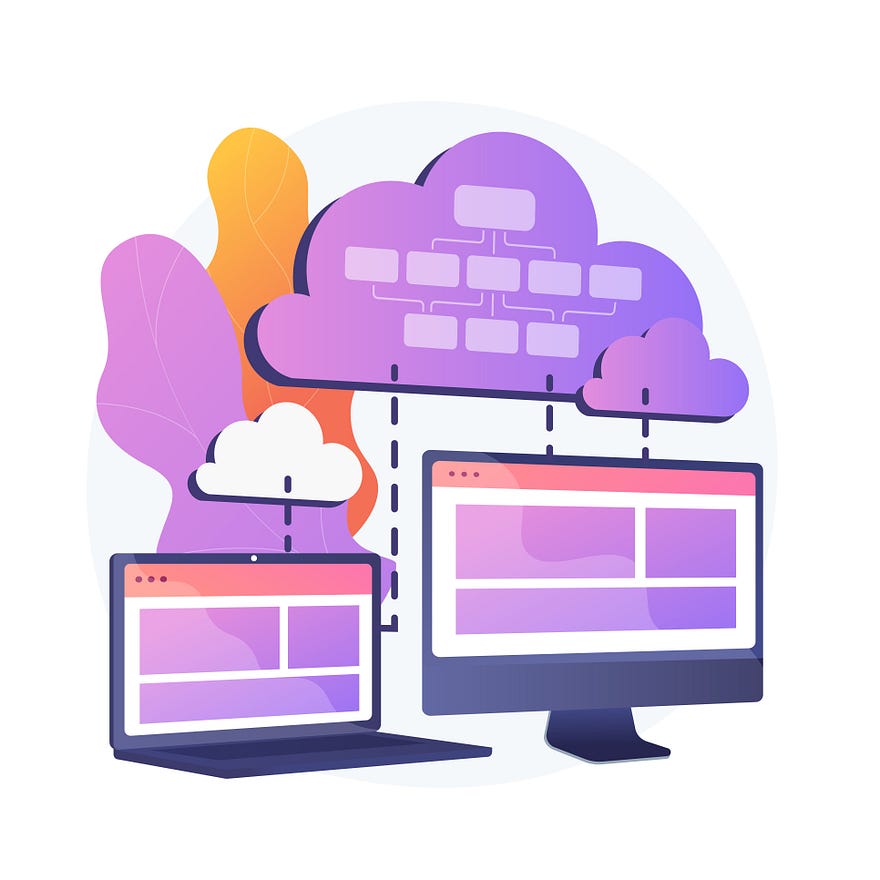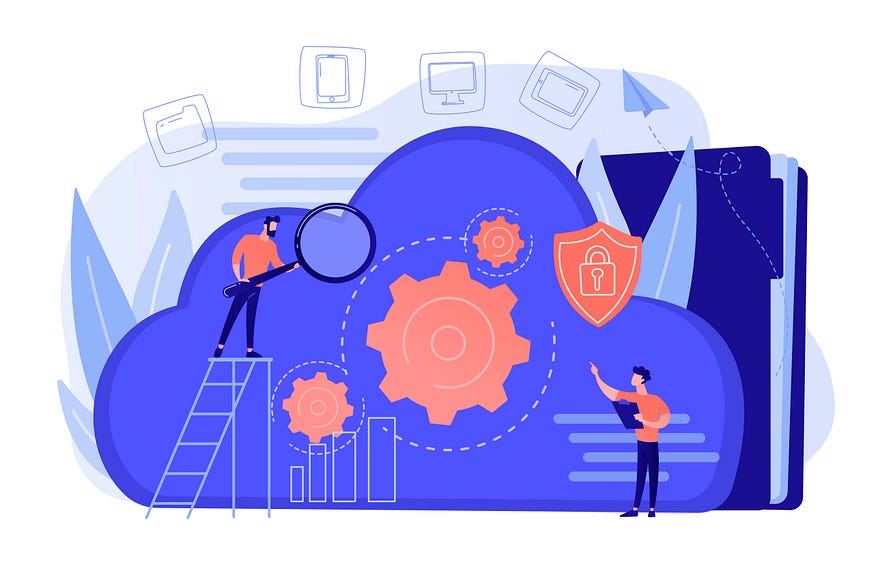
Introduction
Cloud computing has become an essential part of modern business, enabling companies to store and process vast amounts of data in a secure, efficient, and cost-effective manner. The technology has come a long way since its inception, evolving from a basic concept of remote data storage to a complex ecosystem of cloud-based services and platforms. In this article, we will explore the evolution of cloud computing and its influence on business.
We will examine the two generations of cloud computing, the benefits of cloud computing for businesses, and the challenges and risks associated with adopting cloud technology. Ultimately, this article will provide an in-depth understanding of the role of cloud computing in modern business and offer insights into the future of this rapidly evolving technology.

Evolution of Cloud Computing
The first generation of cloud computing emerged in the 1960s during the mainframe computing era. Mainframe computers were large and expensive, and only a few organizations could afford them. To make the most of their investments, organizations allowed multiple users to access the mainframe through time-sharing systems. This marked the beginning of cloud computing, where a large computing resource could be shared among multiple users.
In the 1990s, utility computing emerged as the next stage in the evolution of cloud computing. This model was based on the idea of providing computing resources on a pay-per-use basis, much like a utility company charges customers for electricity usage. This allowed organizations to reduce their hardware and software costs, as they only had to pay for the resources they used.
This generation of cloud computing laid the foundation for the modern cloud computing ecosystem. It enabled organizations to share computing resources and reduce their costs, paving the way for the emergence of new cloud-based services and platforms. Today, cloud computing has become an integral part of modern business, enabling organizations to scale their operations and reduce their IT costs, among other benefits.
Second Generation of Cloud Computing
The second generation of cloud computing emerged in the early 2000s and is characterized by the emergence of virtualization technology. Virtualization allows multiple virtual machines to run on a single physical server, enabling organizations to make more efficient use of their computing resources. This led to the development of cloud services and infrastructure, such as Amazon Web Services (AWS) and Microsoft Azure, which enabled organizations to access computing resources on demand.
Mobile cloud computing is another key feature of the second generation of cloud computing. With the widespread adoption of smartphones and tablets, mobile devices have become an important part of modern business. Mobile cloud computing enables organizations to provide their employees with access to computing resources and applications from anywhere in the world, using their mobile devices.
It has had a profound impact on modern business. It has enabled organizations to reduce their IT costs, scale their operations, and increase their agility. With the emergence of new technologies such as artificial intelligence and the Internet of Things, cloud computing is likely to play an even more critical role in the future of business.
Influence of Cloud Computing on Business
Cloud computing provides businesses with an opportunity to reduce capital expenditure on physical infrastructure such as servers and data centers. This is because cloud service providers typically own and manage the infrastructure needed to host applications and data, which businesses can rent on a pay-as-you-go basis. Additionally, cloud computing enables businesses to scale up or down their computing resources depending on demand, thereby eliminating the need to invest in expensive hardware that may remain underutilized.
Another way that cloud computing improves cost efficiency is by reducing the need for in-house IT staff. Cloud service providers typically offer technical support, maintenance, and security services as part of their packages. This means that businesses can save on the cost of hiring and training IT personnel, which can be expensive. By outsourcing these services to cloud providers, businesses can focus on their core competencies while relying on cloud providers to manage their IT infrastructure. Ultimately, cloud computing can help businesses reduce their overall IT costs, increase operational efficiency, and improve their bottom line.
Scalability and Flexibility
Scalability and flexibility are two critical factors that have made cloud computing a game-changer for businesses of all sizes. Cloud computing allows businesses to easily scale their computing resources up or down depending on their needs. This means businesses no longer need to invest in expensive hardware and software solutions that may remain underutilized. Instead, businesses can rely on cloud service providers to provide computing resources on a pay-as-you-go basis. As a result, businesses can quickly respond to changing market conditions and adapt their computing resources accordingly, which can be crucial in highly competitive industries.
It also enables businesses to be more flexible in their operations. Cloud service providers offer a range of solutions that can be accessed from anywhere with an internet connection. This means that employees can work from anywhere, at any time, using any device, which can be beneficial for businesses that have a distributed workforce. Moreover, cloud computing allows businesses to easily collaborate with external partners and customers. By sharing data and applications over the cloud, businesses can improve their agility and responsiveness, which can lead to a competitive advantage in the marketplace.
Ultimately, scalability and flexibility are two key benefits of cloud computing that can have a significant impact on a business’s success. By allowing businesses to quickly and easily adjust their computing resources and operations to meet changing market conditions, cloud computing can help businesses stay ahead of the competition. Additionally, by enabling employees to work from anywhere and collaborate more effectively, cloud computing can help businesses become more agile and responsive to customer needs.
Improved Collaboration and Productivity
With cloud computing, businesses can leverage various collaboration tools and software that allow teams to work together more efficiently. These tools can include online chat, video conferencing, document sharing, and project management software, among others. By enabling teams to work together in real-time, regardless of their physical location, cloud computing can improve communication and collaboration among team members, leading to increased productivity and better results.
Also, it allows businesses to access the latest software and applications without the need for expensive hardware and software upgrades. This means that businesses can stay up-to-date with the latest technology, which can improve their efficiency and productivity. Additionally, cloud service providers typically offer regular updates and maintenance, which can reduce downtime and ensure that businesses are always running the latest version of their software.
Moreover, cloud computing can help businesses automate repetitive tasks, freeing up employees’ time to focus on more strategic work. For instance, businesses can automate routine administrative tasks such as data entry and invoicing, which can reduce errors and save time. By automating these tasks, businesses can improve their efficiency and productivity, allowing them to focus on their core competencies and achieve their goals more quickly and effectively.

Applications in Business
Cloud storage is a type of cloud computing service that enables businesses to store and access their data over the internet. With cloud storage, businesses can store their data on remote servers that are managed by cloud storage providers, instead of storing them on their local servers or hard drives. Cloud storage offers businesses a cost-effective and scalable solution for managing their data, as they only need to pay for the amount of storage space they use, and can easily increase or decrease their storage capacity as their business needs change.
Businesses are also provided with the ability to access their data from anywhere, at any time, as long as they have an internet connection. This makes it easier for businesses to collaborate and share data with their employees, customers, and partners, regardless of their location.
Also, cloud storage providers typically offer robust security features, such as data encryption, backup and disaster recovery, and access controls, to ensure the safety and privacy of their customers’ data. As such, cloud storage has become an essential tool for businesses of all sizes and industries that rely on data to run their operations.

Cloud Computing for Software Development
This is a cloud computing service that allows businesses to build, test, and deploy software applications over the internet. With cloud computing for software development, businesses can access virtualized computing resources, such as servers, storage, and networking, on-demand, and pay only for the resources they use. This allows businesses to scale their development environments up or down as needed, reducing the costs associated with maintaining their hardware and infrastructure.
The ability to collaborate and share code across teams and locations is a key benefit of cloud computing for software development. Developers can use cloud-based platforms and tools to work on the same codebase simultaneously, and can easily test and deploy their applications across different environments.
Plus, cloud computing for software development enables businesses to leverage emerging technologies, such as containers and microservices, to build scalable and resilient applications. As such, cloud computing for software development has become a popular choice for businesses looking to improve their software development processes and accelerate their time-to-market.

Cloud-based Customer Relationship Management (CRM)
Cloud-based customer relationship management (CRM) is a type of cloud computing service that enables businesses to manage their customer relationships and interactions over the internet. With cloud-based CRM, businesses can access their customer data from anywhere, at any time, and across multiple devices.
Cloud-based CRM provides businesses with a centralized platform for managing their sales, marketing, and customer service processes, as well as automation tools that can help streamline their workflows and improve their productivity. It also offers businesses the flexibility and scalability they need to adapt to changing customer needs and business requirements, while also reducing the costs associated with managing their own on-premise CRM infrastructure.

Future of Cloud Computing
Edge computing is a distributed computing paradigm that brings computation and data storage closer to the source of data generation, such as IoT devices, sensors, and mobile devices, instead of relying solely on centralized cloud servers. Edge computing enables businesses to process and analyze data in near real-time, reducing the latency and bandwidth requirements associated with cloud computing.
Besides, edge computing can improve the reliability and security of data processing and storage, as well as enable businesses to operate in disconnected or low-bandwidth environments. As such, edge computing has become an important aspect of the future of cloud computing, particularly in industries such as healthcare, manufacturing, and transportation, where low latency and high reliability are critical for business operations.
Integration of Machine Learning (ML) and Artificial Intelligence (AI)
The integration of machine learning (ML) and artificial intelligence (AI) is a major trend in the future of cloud computing. Cloud providers are investing heavily in developing AI and ML tools that can help businesses automate and optimize their operations, improve their decision-making processes, and create more personalized customer experiences.
By leveraging cloud-based AI and ML services, businesses can easily build and train custom models on large datasets, as well as integrate these models into their existing workflows and applications. This can enable businesses to unlock new insights and opportunities, such as predictive maintenance, fraud detection, and natural language processing, and stay competitive in an increasingly data-driven market.

Challenges and Risks of Cloud Computing
With cloud computing, businesses are entrusting their sensitive data to third-party cloud providers, which can potentially increase the risk of data breaches, cyber-attacks, and unauthorized access. Cloud providers typically have a shared responsibility model, where they are responsible for securing the underlying infrastructure, while the customers are responsible for securing their own data and applications. As such, it is essential for businesses to implement robust security measures, such as data encryption, access controls, and backup and recovery, to protect their data in the cloud.
Another major concern related to data security and privacy in cloud computing is compliance with regulations and standards, such as GDPR, HIPAA, and PCI DSS. Businesses need to ensure that their cloud providers are compliant with these regulations and that their own data management practices are also in line with these standards.
Failure to comply with these regulations can result in legal and financial consequences, as well as damage to a business’s reputation. As such, businesses need to carefully evaluate their cloud providers’ security and compliance capabilities, implement appropriate measures to protect their data and ensure compliance with relevant regulations and standards.
Dependence on Service Providers
With cloud computing, businesses rely heavily on third-party cloud providers to provide reliable and secure computing infrastructure and services. This dependence can create several risks, including vendor lock-in, service disruptions, and lack of control over data and applications. Businesses need to carefully evaluate their cloud providers’ service level agreements (SLAs), performance metrics, and disaster recovery plans to ensure they get the level of service they require. In addition, businesses need to have contingency plans in place, such as backup and recovery strategies, in case of service disruptions or provider failures.
Conclusion
Cloud computing has come a long way since its inception and has significantly transformed the way businesses operate. The evolution of cloud computing from basic storage and computing services to advanced AI and ML capabilities, edge computing, and serverless computing has made it a powerful tool for businesses of all sizes. Cloud computing has influenced businesses in many ways, including reducing costs, improving productivity, enhancing collaboration, and providing scalability and flexibility to meet changing business needs.
The future of cloud computing looks promising, with continued investment in new technologies and services such as edge computing, serverless computing, and AI and ML. However, businesses need to be aware of the challenges and risks associated with cloud computing, such as data security and privacy, vendor lock-in, and dependence on service providers.
To fully realize the benefits of cloud computing and mitigate these risks, businesses need to carefully evaluate their cloud providers, implement appropriate security measures and compliance strategies, and develop contingency plans for potential disruptions or failures. Ultimately, the adoption of cloud computing will continue to play a significant role in shaping the future of business, enabling companies to innovate, grow, and succeed in an increasingly digital world.
